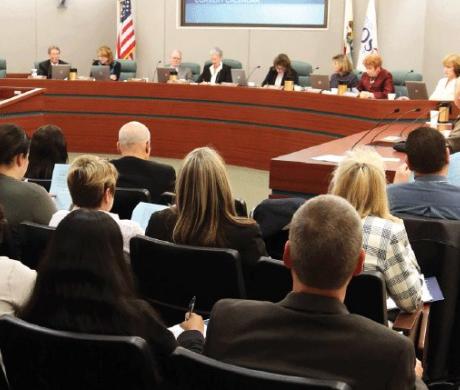Is Your City Council Stifling Innovation? Tips to Promote Smart Risk-Taking
This article is a service of the nonprofit Institute for Local Government (ILG), whose mission is to promote good government at the local level with practical, impartial and easy-to-use resources for California communities. Frank Benest is a former city manager of Palo Alto and currently serves as a senior advisor to the International City/County Management Association. For more information about ILG, visit www.ca-ilg.org.
Today, innovation is imperative for effective city governance. Cities are confronting economic stress, demographic and social shifts and facing opportunities posed by new technologies. Council members often encourage staff to innovate for a variety of reasons:
- Constituents want better, cheaper, faster approaches;
- The big challenges — traffic congestion, affordable housing, gangs, economic vitality and environmental sustainability — all require shared service approaches, cross-sector partnerships, public engagement, new technologies and other creative solutions;
- Council members want to make a positive difference in their communities and leave a legacy; and
- Innovation creates an attractive record for re-election.
However, some council members may often discourage — if not crush — innovation because they do not like risk and failure. They tolerate and sometimes even promote a zero-risk environment, which is antithetical to creative approaches. Yet there can be no innovation without risk and failure.
Picture this example. As a council member, you attend a regular council meeting where one of your residents gets up to criticize a traffic-calming program that staff is proposing along a particular corridor. In response to a council priority to improve bike and pedestrian safety, the plan calls for eliminating a car lane and installing a bike lane and roundabout. The resident calls the plan a stupid idea, claiming that it will cause cut-through traffic on his street and says that the chief transportation official is an idiot. One of the other council members also joins in criticizing the proposal and the staff.
The implicit message in this situation is that staff will be criticized for recommending any creative approach that may result in a mistake, failure or opposition, so it is better to play it safe.
Innovation Requires Risk
Innovation requires risk-taking — not wild gambles, but calculated risks. For innovation to occur, staff must risk money and other resources, such as time and their reputations. Most importantly, they must risk mistakes and likely criticism. Staff will not innovate when top management or elected officials criticize every misstep or mistake. Instead, staff will try to make any recommendation or proposal perfect and safe with no chance of failure before putting it forward.
That’s not how innovation occurs. Innovation involves taking a challenge (for example, traffic congestion) without a proven solution — or a problem for which every stakeholder group has a different preferred solution — and experimenting with various approaches, making mistakes and fixing things as the process unfolds.
Unless council members and top management create an environment that encourages “smart” risks, there will be little if any innovation regardless of how much the council desires it.
Strategies for Council Members
Council members must go beyond exhorting staff to innovate. My experience as a long-time city manager in several communities and as a consultant promoting innovation suggests that the council must help create a safe environment for responsible risk-taking. While there is no perfect way to do this, these tips offer some helpful strategies.
Don’t allow people to personally criticize staff for well-intentioned efforts. This is critical if your council is serious about promoting innovation. Set this ground rule: It’s OK to criticize ideas or policies but not the people involved. As council members, you must model this behavior and observe rules of decorum that inhibit staff-bashing.
Call everything a “pilot” project, even if it is not technically a pilot. Why? Residents will more likely expect some mistakes or failures if it is a trial from which the city will learn what works and what does not.
Conduct a risk assessment in public. Discuss publicly the concept that innovation does not occur without some risks and inevitable errors. Require staff to conduct a risk assessment as part of an innovative proposal. Then at a public meeting council members can discuss what is a responsible risk versus what may be a gamble or reckless risk and thoughtfully balance potential downsides and upsides.
Tie the innovative proposal to the larger agenda. It is easier to promote a risk if it can be linked to priorities or a strategic plan already approved by the council or if it can be discussed as an extension of another public or private investment currently under way.
Create a small innovation or risk fund. Ask the city manager to budget a small pool of money to be spent on creative ideas, for which groups of employees and perhaps community partners can compete. Make sure to report back to the council and community on the lessons learned for future innovation. Identify wherever possible the return on investment over time. The net “gain” — for example, cost savings, productivity improvements and reductions in crime or traffic — will offset the losses from other projects that do not pan out.
Engage in proactive media communications. While there is never any guarantee of positive coverage, it’s always a good idea to meet proactively with media representatives so they understand the rationale for the innovative approach, what is and is not being proposed as well as the risk assessment that is being conducted.
Take action before every question or concern has been addressed. The great organizations in the private and public sectors use a “ready, fire, aim” approach. They try to get things “roughly right,” knowing that any creative approach will need adjustments as efforts unfold. Often, in the face of controversy a council decides to send an innovative proposal back for more staff work countless times until the idea dies or staff just gives up.
Partner with a nongovernmental group and spread the risk. Collaborating with a nongovernmental partner can generate more and better ideas on how to address the challenge. Given the trust deficit experienced by many city governments, the partner can also take the lead in presenting a particular innovation. This approach also spreads the risk and some of the costs.
Take an incremental approach to risk and innovation. If the city takes a few incremental steps in starting a project, it is easier to back off from a risky project if things go terribly wrong or significant opposition arises. Typically, such initial steps do not require a large financial investment at the outset. In other words, it is reversible. Conversely, if the initial efforts create positive results, the city can slowly build momentum and public support for the endeavor.
Be transparent about any results, especially mistakes, yet demonstrate reasonable restraint in your criticism. Ensure that staff discloses any failures and what is being done to correct the situation. Express any concern about the lack of progress or any failure to achieve what was intended, and make any helpful suggestions.
Debrief with staff and the community. At key points along the way as well as at the end of an experimental effort, ask:
- Given our goals, what has gone well?
- What has not gone so well?
- How did we respond to inevitable problems?
- What did we learn for the future?
Celebrate “fabulous flops.” Certainly a few moments should be taken at a council meeting to recognize a successful project and the staff and community partners involved. However, it can also be powerful to celebrate audacious efforts that fall flat. Recognizing such “fabulous flops” with humorous awards can encourage staff and partners to experiment even if the idea ultimately fails.
Provide a Professional Safety Net
The council helps set the tone for the organization. Staff will not take risks to innovate in a culture of fear. Elected officials must provide a professional safety net to encourage responsible risk-taking and ensure that innovation is not just talk from the council dais.
Additional Resources
Institute for Local Government Publication:
This article appears in the April 2014 issue of Western City
Did you like what you read here? Subscribe
to Western City








